 NewsletterTemplate
BP SPECIES
NEWSLETTER June 2012
July
00 Aug
Sept
Oct
Nov
Dec
Jan
01 Feb
Mar
April
May
June
July
Aug
Sept
Oct
Nov
Dec
Jan
02 Feb
March
April
May
June
July
Aug
Sept
Oct
Nov
Dec
Jan
03 Feb
March
April May
June,July
Aug,Sept
Oct.Nov
Dec
Jan04
Feb04
MarchApril04
Jan05
Feb05
March05
April05
May05
June05
July05 Aug05
April06
May06
June
06 July
06
August06
Jan07
May
2012
WHATS
NEW ?
In FLASK.
Catasetum tabulare Cattleya lawrenceae Dendrobium spectabile Grammatophyllum
marteae Spathoglottis plicata "bulbosa magenta x redmagenta" Spathoglottis
sulawesiense
NewsletterTemplate
BP SPECIES
NEWSLETTER June 2012
July
00 Aug
Sept
Oct
Nov
Dec
Jan
01 Feb
Mar
April
May
June
July
Aug
Sept
Oct
Nov
Dec
Jan
02 Feb
March
April
May
June
July
Aug
Sept
Oct
Nov
Dec
Jan
03 Feb
March
April May
June,July
Aug,Sept
Oct.Nov
Dec
Jan04
Feb04
MarchApril04
Jan05
Feb05
March05
April05
May05
June05
July05 Aug05
April06
May06
June
06 July
06
August06
Jan07
May
2012
WHATS
NEW ?
In FLASK.
Catasetum tabulare Cattleya lawrenceae Dendrobium spectabile Grammatophyllum
marteae Spathoglottis plicata "bulbosa magenta x redmagenta" Spathoglottis
sulawesiense
In PLANTS.
Due to the continuing potting and repotting schedule, we suggest that you
send your want list of species by email to ianbpon(at)speciesorchids.com
Please substitute @ for (at) to avoid Spam. A reply by email
will advise current stocks of plants of interest. Some species are listed
below.
Ready
to replate. Ancistrochilus rothschildianus
Catasetum luridum Cattleya aclandeae Dendrobium langpongense Eulophia(Oceoclades)roseovarigata Leptotes bicolor Liparis
nigra
Culture.
Trichoglottis
International
payments. Paypal,
Western Union, Bank EFT.
CITES. Flasks
exempt.
Seed
for sale. Email
now for a list of available species orchid seed.
Cloud Forest
Institute. Join
Conservation of cloud forest.
http://www.speciesorchids.com
Web Site. Full descriptions of species flasks and plants
plus photographs. Details on ordering, shipping and cultural notes.Links
to other interesting sites. Articles on culture, habitat and notes about
orchids.
Humour.
Have a laugh on us and Keep Smiling.
LISTS
Requests for lists or to Subscribe or Unsubscribe;
Email to ianbpon(at)speciesorchids.com (Please
substitute @ for (at) to avoid Spam)
It is our policy to avoid spam, so lists are only
sent on request.
Highlighted species or subjects
are links to photos/articles.
Just click on the subject.
Items in this Newsletter may be reproduced
provided source acknowledged. Do you know any orchid growers who may like
to receive this newsletter? Why not forward this email to them now!
We commend "Orchids Online
Web Design" for the excellent work on our web site.
For information or prices
comtact Steve at webaddress below.
Steve is looking for Orchid
Society and Orchid Nursery Information to include on his site.
If you can help, why not
visit his website at http://www.orchidsonline.com.au/
and fill in the online form now.
.
New
in Flask.
left Dend spectabile centre Gramm marteae right Spath sulawesiense white
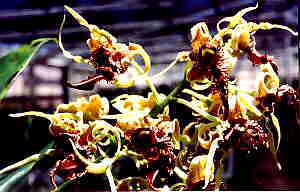 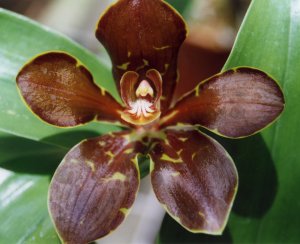 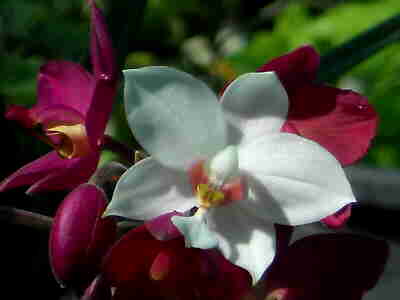 Catasetum tabulare. Green yellow, large whitish plate like
labellum.
Cattleya lawrenceae. A Venezuelan species, with white to
pale rose, rose violet sepals and petals, the labellum midlobe
brilliant rose-purple. Use a well drained media in a pot or basket.
Dendrobium spectabile. New Guinea. large weird twisted flowers.
Will grow intoa large specimen in a pot or basket, use a well drained media
that will stay damp but not wet.
Grammatophyllum marteae.A large robust grower, basket culture
in a somewhat semiterrestrial media.
Spathoglottis plicata "bulbosa magenta x redmagenta" Terrestrial.
Rich leafmould and sandy soil mix. .This is the combination of a dark magenta
x deep redmagenta for its brilliant colour that will stand out in
the orchid house. Both forms are large robust growers that could also be
planted in the garden.
Spathoglottis sulawesiense. Tall erect spike of elegant well
shaped white flowers, the lip lobes pink to purple.Anothet large
robust grower with a spike to nearly a metre high, progressively flowering.
.Top
New
in Plants
Catasetum tabulare. Green yellow, large whitish plate like
labellum.
Cattleya lawrenceae. A Venezuelan species, with white to
pale rose, rose violet sepals and petals, the labellum midlobe
brilliant rose-purple. Use a well drained media in a pot or basket.
Dendrobium spectabile. New Guinea. large weird twisted flowers.
Will grow intoa large specimen in a pot or basket, use a well drained media
that will stay damp but not wet.
Grammatophyllum marteae.A large robust grower, basket culture
in a somewhat semiterrestrial media.
Spathoglottis plicata "bulbosa magenta x redmagenta" Terrestrial.
Rich leafmould and sandy soil mix. .This is the combination of a dark magenta
x deep redmagenta for its brilliant colour that will stand out in
the orchid house. Both forms are large robust growers that could also be
planted in the garden.
Spathoglottis sulawesiense. Tall erect spike of elegant well
shaped white flowers, the lip lobes pink to purple.Anothet large
robust grower with a spike to nearly a metre high, progressively flowering.
.Top
New
in Plants
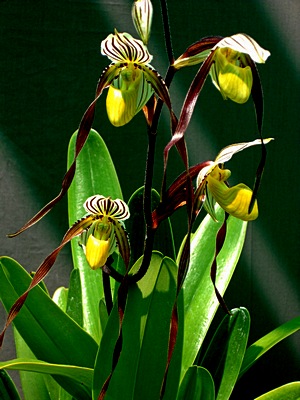 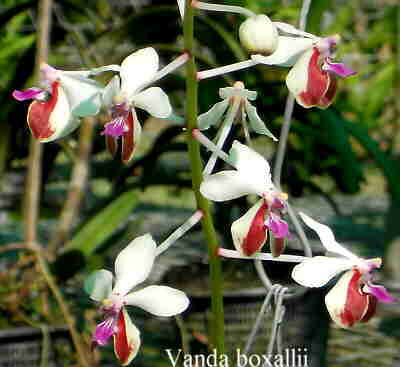  Paphiopedilum roebellinii ( above) .Typical
paph media, lots of sunlight short of leaf burn to promote flowering. Grow
with the dendrobiums, not in heavy shade.
Paphiopedilum laevigatum.Similar to roebellinii,
with shorter petals that tend to spread rather than be pendulous.
Dendrochilum formosanum. A charming minature
that wil develop into a specimen plant in a 4 inch pot. A fine media that
will stay damp but not wet.
Dendrochilum propinqum. A minature form of
convollarieforme, with pale greenish flowers.This species will grow into
a large specimens in a small pot or basket like D formosanum.
Vanda boxallii .A warm grower, use large
coarse media in a basket or slotted pot.
.
Top
Ready
to Replate.
Paphiopedilum roebellinii ( above) .Typical
paph media, lots of sunlight short of leaf burn to promote flowering. Grow
with the dendrobiums, not in heavy shade.
Paphiopedilum laevigatum.Similar to roebellinii,
with shorter petals that tend to spread rather than be pendulous.
Dendrochilum formosanum. A charming minature
that wil develop into a specimen plant in a 4 inch pot. A fine media that
will stay damp but not wet.
Dendrochilum propinqum. A minature form of
convollarieforme, with pale greenish flowers.This species will grow into
a large specimens in a small pot or basket like D formosanum.
Vanda boxallii .A warm grower, use large
coarse media in a basket or slotted pot.
.
Top
Ready
to Replate.
Ancistrochilus rothschildianus Cattleya aclandeae
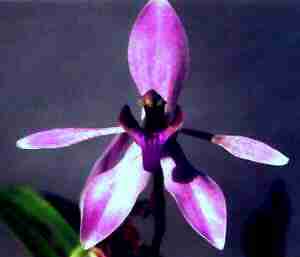 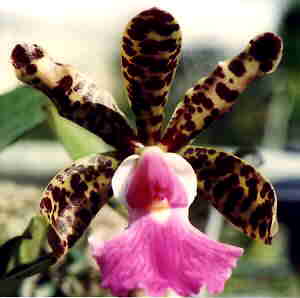  Dendrobium lampongense
Ancistrochilus rothschildianus. African. semiterrstrial
media, deciduous.Keep dry in winter.
Cattleya aclandeae. Small grower, treefern slab or open
media in well drained pot or basket.
Dendrobium langpongense. Pedilonum Bottle brush type. Small
well drained pot with a media that will stay damp but not wet.
Eulophia (Oceoclades) roseovarigata. Semi terrstrial, variagted
foliage, shade grower, rests in winter.
Leptotes bicolor. Minature with proportionally large white
flowers, lip purple magenta, treefern slab or small well drained pot.
Liparis nigra. Terrestrial, semiterrestrial, hansome large
leafy plant with very dark maroon flowers,very showy. Use a well drained
fine media, rest in winter.
More photos at
www.speciesorchids.com/photos.html
Top
Culture.
TRICHOGLOTTIS. Dendrobium lampongense
Ancistrochilus rothschildianus. African. semiterrstrial
media, deciduous.Keep dry in winter.
Cattleya aclandeae. Small grower, treefern slab or open
media in well drained pot or basket.
Dendrobium langpongense. Pedilonum Bottle brush type. Small
well drained pot with a media that will stay damp but not wet.
Eulophia (Oceoclades) roseovarigata. Semi terrstrial, variagted
foliage, shade grower, rests in winter.
Leptotes bicolor. Minature with proportionally large white
flowers, lip purple magenta, treefern slab or small well drained pot.
Liparis nigra. Terrestrial, semiterrestrial, hansome large
leafy plant with very dark maroon flowers,very showy. Use a well drained
fine media, rest in winter.
More photos at
www.speciesorchids.com/photos.html
Top
Culture.
TRICHOGLOTTIS.
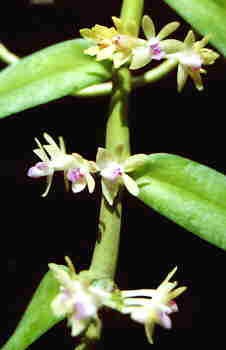  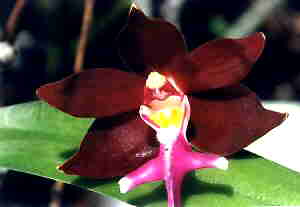
.jpg) .jpg) Photos L to R; T batanense, T breviracema, T brachiata,
T loheriana, T tomentosa..
Photos L to R; T batanense, T breviracema, T brachiata,
T loheriana, T tomentosa..
There are some 30 odd species in the genus, and the following Trichoglottis
species do well in North Queensland. in our warm tropical climate.
There are basically two types
of Trichoglottis, one has thin pendulous stems with small flowers along
the stem and includes the Australian species, Trichoglottis
australiensis, and the exotic Trichoglottis batanense, latisepala, rosea
and breviracema
The second type are erect
growing plants, much like Vandas etc, and listed below are some of
the species in cultivation. Species with panicles or short racemes
were previously called Stauropsis and are not climbers, producing
shoots at the base and developing into clumps. The climbing types produce
roots along the stem and requires something to clamber up.
The pendulous species.
Trichoglottis australiense. Pale yellow brown flowers,spotted
brown.
Trichoglottis latisepala. In good sunlight, the leaves
turn red. Flowers 2 or 3 at a node, bright pink purple.
Trichoglottis breviracema ( rosea var breviracema). A species
from Taiwan, with pearl pink flowers somewhat larger than those of
latisepala.
Trichoglottis batanense. Pale yellow flowers spotted brown,
with a pink to purple lip.
Erect growers that
clump.
Trichoglottis ionosma
has a branched spike of 3 cm flowers, yellow, blotched and
barred redbrown. The lip is heart shaped and white. It hales from Taiwan
and the Philippines Also know as Trichoglottis cunelabris in
the Nursery trade.
Trichoglottis luchuense
also has a branched spike habit, with 3 cm yellow flowers, blotched and
spotted brown. The lip is cross shaped, red brown. A Philippine and Formosan
species.Like Trichoglottis ionosma, these do best in pots or a basket
as they do not climb.
Trichoglottis loheriana
( davisii).A large robust grower with thick somewhat curved leaves. The
spike is branched with pale green to greenyellow flowers with dark
brown to almost black. spots and streaks. A hansome plant, even when not
in flower.
Trichoglottis luzonense
is a more compact plant, with wider leaves and is slow growing. The
branched spikes carry numerous 4 cm flowers, yellow barred red
brown, much like a small Arachnis flower. Another non climber, basket culture
used, and perhaps a little more shade.
Climbers
The following species of South East Asia, and the Philippines.
Trichoglottis
brachiata has 5cm heavy textured flowers of rich maroon, the
lip mostly purple, cross shaped, sometimes referred to as the Black Orchid.
The flowers are produced along the stem. A climber requiring something
to clamber up. It is perhaps the most spectacular of the species.
Trichoglottis
philippinense is the pale yellow, brown blotched form of Trichoglottis
brachiata, with flowers to 4 cm, pale yellow around the edges, lip white
flushed pink.
Trichoglottis
wenzellii, a rampant grower, has green yellow flowers with concentric
red veins, the lip is long and white. Very fragrant, well worth growing
for the perfume which will fill the orchid growing area during the warmer
hours.
Trichoglottis
retusa, a smaller grower, has 2cm yellow green flowers with brown
blotches, produced along the stem, the lip is white.and furry.
Trichoglottis
tomentosa (sagarikii), a very pretty species with 3 cm flowers, yellow
with redbrown blotches, the lip is white and purple.
Trichoglottis
fasciata, grown locally for half a century, was also known as Stauropsis
fasciata.
This species produces short spikes of 3 or 4 flowers, each about
6 cm long, white outside, inside yellow green with wide bars of redbrown,
very fragrant.
All the Trichoglottis
grow well either in a bushhouse or outdoors, with broken sunlight and protection
from direct hot sunlight. Pot media; anythng, as long as it drains well
and hold some moisture.. The climbers need something to clamber up, and
can be kept managable by cutting tops and replanting at the base of the
support for a specimen clump. The pendulous species do well in a basket.
They like plenty of water,
benefit from regular fertilizing and mostly flower at different times,
some are particularly fragrant and all flower regularly.
Text & Photographs by Ian Walters , Burleigh Park,
54 Hammond Way, Thuringowa, 4815
More photos at
www.speciesorchids.com/photos.html
Top
Seed
of SPECIES orchids.
Email to ianbpon(at)speciesorchids.com
(Please substitute @ for (at) to avoid Spam) .for the
latest list of seed available in packets enough to prepare 3 to 4 flasks.
Cattleya, Coryanthes, Dendrobium, Oncidium, Laelia, Aerides
with more added as harvested.
All seed dated at collection, airmail post world wide and there
is no restriction on orchid seed.
CONSERVATION BY PROPAGATION.
Conservation of cloud forest
flora and fauna.
Join Cloud Forest Institute
THIS IS A VERY IMPORTANT INITIATIVE PLEASE SEE
"http://www.cloudforest.org" FOR MORE INFORMATION
Join Cloud Forest Institute, a federally recognized 501(c)3
to fund a wildlife corridor in the Ecuadorian
Tropical Andes and protect it - forever!
The two parcels comprising of 840-acres of Cloud Forest in the
Ecuadorian Paso Alto Range of the Andes
in the Cambugan Watershed is home to jaguars, spectacled bears,
over 300 species of ORCHIDS, and the
highest number of endemic amphibian and bird species in
the WORLD. Concerned people are encouraged to make tax-deducatible donations
and create honorary groves in their name.
CITES.
Flasks are EXEMPT under Convention on International Trade in
Endangered Species of Wild Fauna and Flora (CITES), Title 50, Part 23,
Subpart C, Appendix II.
S 23.23 (d) (6) Specifically exempted: For orchidacea species:
(i) in Appendix I, seedling or tissue cultures obtained in vitro,
in solid or liquid media, transported in sterile containers.
International payments.
Top
Paypal, Western Union, Bank EFT.
Paypal; International transfer of payments by credit card. Log
onto "https://www.paypal.com" register, and follow the easy instructions.
When making payments by Paypal, remember to add 4% for their
transfer fee.
Our Paypal address advised when applicable.
Important Note; Due to high Bank fees, we recommend the use
of Paypal
or Western Union (http://www.westernunion.com/index_consumer.asp?country=US)
transfers when sending international payments. It is quick and
secure. Electronic Funds Transfer by Bank is also quick and secure, but
check Bank fees for the service. Bank details emailed on request.
When sending payments internationally, use REGISTERED airmail
letters or document envelopes and NOT large packets or padded bags which
may be opened by Customs for inspection. Address letters to Ian & Pat
Walters, NOT to the Nursery, so there is no indication of contents.
NOTE. International MoneyGram is not available
for collection here in North Queensland and cannot be accepted.
Top
************
Humour.
A group of rowdy English soccer fans is on a train on the way to
the big match. In the same carriage is an elderly man wearing his teams
colours. Opposite is a young man wearing the oppositions colours, holding
a duck.
They look at each other, and the old man
says, " You know you cannot take a pig into the grounds."
The young man answers " You
silly old fool, this is not a pig, its a duck."
The old man quietly said, "Young man, I was talking to the duck."
Have You Noticed?
No one is listening until you fart.
Always remember you're unique. Just like everyone else.
Never test the depth of the water with both feet.
. If you think nobody cares if you're alive, try missing a couple
of car payments.
If at first you don't succeed, skydiving is not for you.
Top
Ian and Pat Walters,
Burleigh Park Orchid Nursery
54 Hammond Way, Townsville,
Australia 4815
Email us at ianbpon(at)speciesorchids.com
(Please substitute @ for (at) to avoid Spam)
http://www.speciesorchids.com/
Phone 0747 740 008
International 61 747 740 008
For Web Design and Web Hosting
Contact Orchids Online Web Design
TOP |
MAIN |
ABOUT |
FLASK |
PLANT |
ORDER |
INTEREST |
SUPPLIES |
EMAIL |
LINKS
|









 Dendrobium lampongense
Dendrobium lampongense


.jpg)
.jpg)